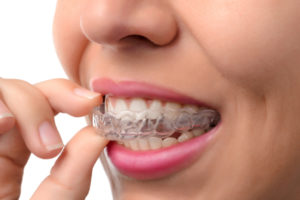There must be a reason behind the 34 percent rise in orthodontics treatments. Orthodontics is a branch of restorative dentistry which deals with the restoration of malpositioned dental structure. Most people think of braces when it comes to straightening teeth, which is indeed a great solution for severe cases. But, if the teeth are moderately malpositioned, dentists recommend wearing Invisalign.
People generally refer to this topic as “braces vs Invisalign,” but little do they know, both can go along very well. In this article, we will discuss when is Invisalign a better option, and why is it a better option?
How are braces different from Invisalign?
Braces are a traditional method of aligning severely crowded teeth. They are made from a thin metal wire fixed with brackets attached to the teeth. They perform extremely well but are often despised because of their unconcealed nature. Dentists claim that braces are ideal for severe cases. They are different from Invisalign in every manner. Invisalign trays are made from invisible plastic covers, customized in labs, and most importantly: INVISIBLE!
When Invisalign becomes the best option?
Invisalign becomes the better option after having the braces. People want to switch to Invisalign (when teeth become better and moderately malpositioned) and dentists also recommend them. Getting straight, perfectly aligned teeth becomes easier with Invisalign.
Invisalign is also the best option when teeth structure has problems such as:
- Slightly crowded teeth
- Gap between teeth
- Bite problems such as underbite, overbite, or crossbite
- Open bite (both upper and lower teeth stretching outwards, in a way that doesn’t touch each other)
And, what are bite problems?
Underbite is a condition where the lower teeth are stretched outwards, known as class III malocclusion. Overbite is a condition in which teeth are severely malpositioned (both upper and lower), also known as malocclusion. Crossbite is a condition where the upper teeth are stretched outwards covering the lower part.
In any of the above conditions, Invisalign is the best option.
Why switch to Invisalign, or even choose it?
- Invisalign trays are easier to wear for a longer time i.e. for 20-22 hours.
- You can also remove them while eating and brushing (in fact, for two-four hours only).
- It is also customized in labs especially for an individual, so you won’t need size adjustments.
- Lastly, the best benefit of having an Invisalign tray is INVISIBILITY!
Will getting Invisalign to save me from visiting the dentist regularly?
Well, the Invisalign tray needs to be replaced after every two weeks. And, the Invisalign treatment is required for 6 months or a year (note that: you are already having moderately crowded teeth).
Is there anything that can affect Invisalign treatment greatly?
- Wearing them for less than 20-22 hours.
- Not being careful while washing the tray (use lukewarm water and rinse gently).
- And, your tooth movement also has an effect on your Invisalign treatment (if your teeth are rigid it might take time to realign them).
- Also losing them…trays!
Is Invisalign treatment good for a 30 years old person?
It is perfect! When a person turns 30, the tooth movement gets better which helps Invisalign work faster and efficiently. But, age doesn’t matter, if you are getting treatment from experienced orthodontists, they know what they are doing!
Psst… new in Chula Vista? Want to connect with the most professional orthodontist in town? Call Dr. Nick now!
